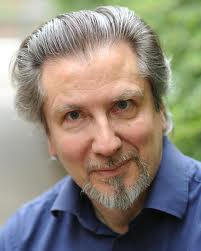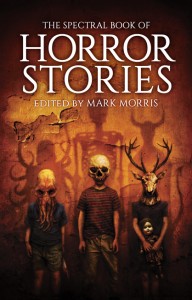 Leading off this week’s Spectral Book of Horror Stories posts is the superbly talented Mr Reggie Oliver, playwright, author, biographer, actor and director. His Tartarus collection Mrs Midnight won the Dracula Society’s Children of the Night Award, and was a finalist for both the British Fantasy and World Fantasy Awards, and Flowers of the Sea is shortlisted for the 2014 World Fantasy Award for Best Collection.
Leading off this week’s Spectral Book of Horror Stories posts is the superbly talented Mr Reggie Oliver, playwright, author, biographer, actor and director. His Tartarus collection Mrs Midnight won the Dracula Society’s Children of the Night Award, and was a finalist for both the British Fantasy and World Fantasy Awards, and Flowers of the Sea is shortlisted for the 2014 World Fantasy Award for Best Collection.
1. Can you remember the first horror story you read that made an impact on you?
Though, not exactly a horror story, but containing horror elements, it was The Hound of the Baskervilles. The legend, the Dartmoor atmosphere, the slow revelation of dark goings on utterly captivated me. It was the first full length novel I ever read. Then, as well as Sherlock Holmes, I immediately devoured other horror stories of Conan Doyle’s: “Lot No. 249”, “The Horror of the Heights”, “The Leather Funnel”, not so well known, but great stuff.
2. What inspired the story you wrote for this anthology?
I had written a story called “Quieta non Movere” (to be found in Best New Horror 23 and elsewhere) about the ghost of a sixteenth century Canon of a cathedral in an imaginary English cathedral city called Morchester. This character, Jeremiah Staveley, stayed in my mind and I felt that there was more to say about him. He wouldn’t let me go. In the previous story I had only hinted at the reasons why he was such a sinister figure, why he was interred standing upright in the walls of the cathedral’s North transept and why he had written for himself such a strange and troubling epitaph. As I began to realise what some of the reasons were, a story began to arrange itself in my mind. The question was: how to tell it? It was then that I decided that Jeremiah, on the point of death, would have to write his own testament, and I would have to risk using sixteenth century language to bring his unique voice and unique terror to life.
3. How would you describe the kinds of stories you usual write and does this Spectral Book of Horror story depart from that?
I don’t think my stories are easily characterised. Some are contemporary, some historical: many have connections with my career in theatre and television, but all have to do in some way with the metaphysical nature of good and evil. This is one of my “historical” pieces in which I use the language and context of another period to conjure up a particular atmosphere of evil and corruption. It is not so much a departure as a pushing of the boundaries of my usual style, to see how far a reader can enter into the world of another age and identify with a Faustian tale from the time of Shakespeare.
4. In your heart of hearts do you prefer your horror to be of the slashy variety or of a more subtle psychological stripe?
I don’t shy away from explicitly violent horror, but I am a great believer in trusting in the reader’s imagination. When I was a child I remember being taken to Madame Tussaud’s waxworks and being told about “The Chamber of Horrors” which was in the museum but which I was not allowed to see. The name was horribly suggestive and I had nightmares about it, but when at last I got to see it, it was really just a series of effigies of distinctly banal looking murderers like Dr. Crippen and not at all the anteroom of hell that my mind had conjured up. I believe in trying to achieve what those words “Chamber of Horrors” did for me as a child, to evoke a world of half-hidden frightfulness, all the more horrible for being half hidden. It is much more artistically exciting to hint, to suggest and then let the reader do the rest. It is fine to be explicit occasionally, but it should be in brief flashes, like a thunder storm at night suddenly illuminating the landscape with leprous light. Aickman talks about good horror being like poetry: it requires the power to create an impression, rather than make a detailed inventory. Besides, for me, true horror has always resided in the moral and spiritual corruption of the inner person of which the physical image – like the House of Usher sinking into the mire – is only a symbol.
5. What are you currently reading? 
I read a lot of fiction, but currently I am reading Catastrophe Europe Goes to War 1914 by Max Hastings. I have long been fascinated by that act of collective insanity known as World War I, an event that shaped our present world more than any other in the last hundred years. The book explores the events of that year and the causes of the war from every point of view, political, sociological, cultural, military, with plenty of revealing personal vignettes. Do I now understand why it all happened? Not entirely, but my view of that calamity has been hugely elaborated and enriched.

